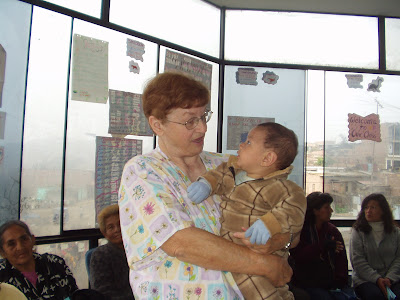
Or, simply, "the community."
A number of years ago, this man - Miguel Rodriguez - was a successful journalist for a Lima newspaper. He had a good job, a family, a house in the suburbs, a car - all the trappings of success -until a young son became ill and died. Leaving the hospital the night of his son's death, he came across a couple of boys living in the streets of Lima, and on impulse, took them home with him. He fed them, cleaned them up and gave them a place to sleep. The next morning they were gone, so Miguel did the sensible thing and counted the silverware. That night, the boys were back - with two of their friends from the streets. Miguel took them in, and also the new children that showed up the next night. And the ones after that. It wasn't long before he lost his job for spending so much time away, taking care of homeless kids. The car was the first thing sold, and before long, the neighbors were so unhappy with the parade of unsavory kids through the neighborhood that they took up a collection and bought Miguel's house!
He found a parcel of land about an hour's drive from Lima and moved the kids out there, establishing the
Comunidad de Niños Sagrada Familia - the Sacred Family Community of Children. And when we were there, his collection of street urchins had grown to more than 680 children - ranging in age from a few months to older teens! Where does he get the money to care for them? He begs. He cajoles, he wheedles, he promotes, he scavenges, he makes do. Whenever a new kid shows up, he says he has two choices; he can take them in, or he can take them in. No one is refused, but once there they live by the community rules or else.

There are fewer than a dozen adults living at the community. The kids raise themselves; older kids help the younger, younger kids help the babies. Everyone works, everyone helps. They go to school half a day and they work the other half. And they live in a safe environment. They are polite, orderly and greet you with hugs and kisses.

We visited the dining hall during lunch one day (they eat in shifts); all the kids present were waiting quietly for the blessing before eating. It was not a blessing in a form that you or I would be familiar with, but rather a "blessing rap" in which the kids in a very lively way expressed thanks and emphasized to each other that they were community. They had meat that day. Someone had given Miguel money and he had purchased chickens. They cut the chickens into 30 pieces each to have enough for everyone to have one small piece of meat. While they generally have enough to eat - oatmeal, lentils, vegetables and melons - this was the first meat in 6 months!
And this is where they cooked it.

Our clinic was held in their new clinic building, a surprisingly good facility for that area, even if it lacked some things - like a roof over the front of the building. We saw children from the community and others from the surrounding area. And when we were done, they held a ceremony and gave us each ribbons and certificates. I consider them treasures.






 And how long did it take to work this one out?
And how long did it take to work this one out?

























